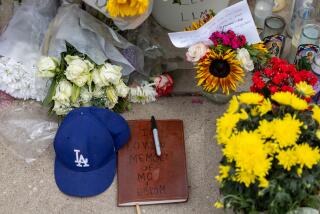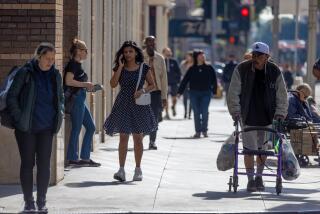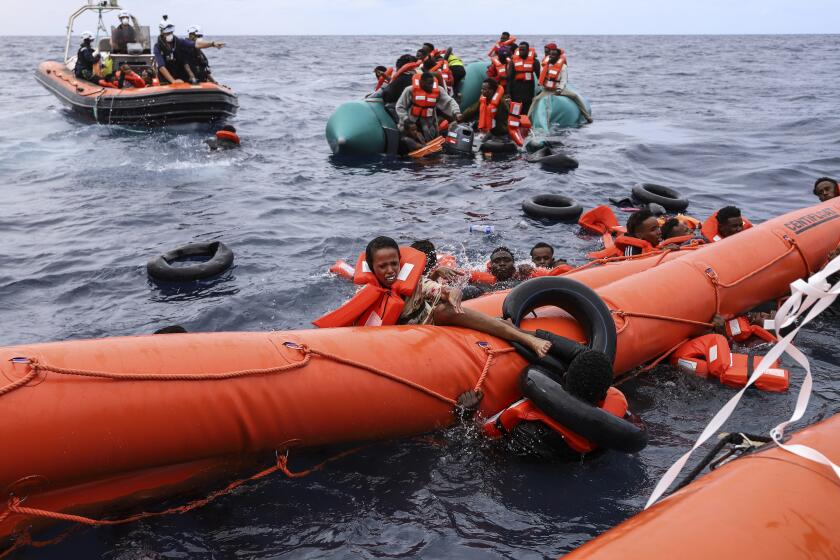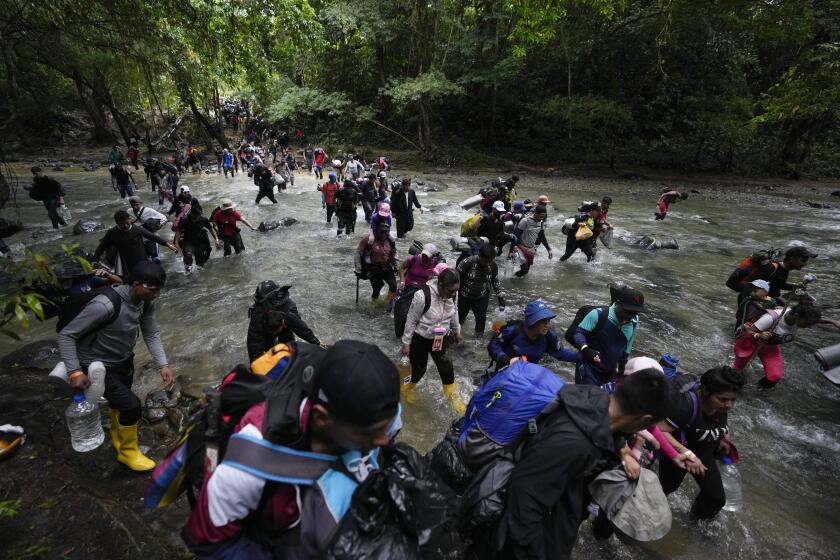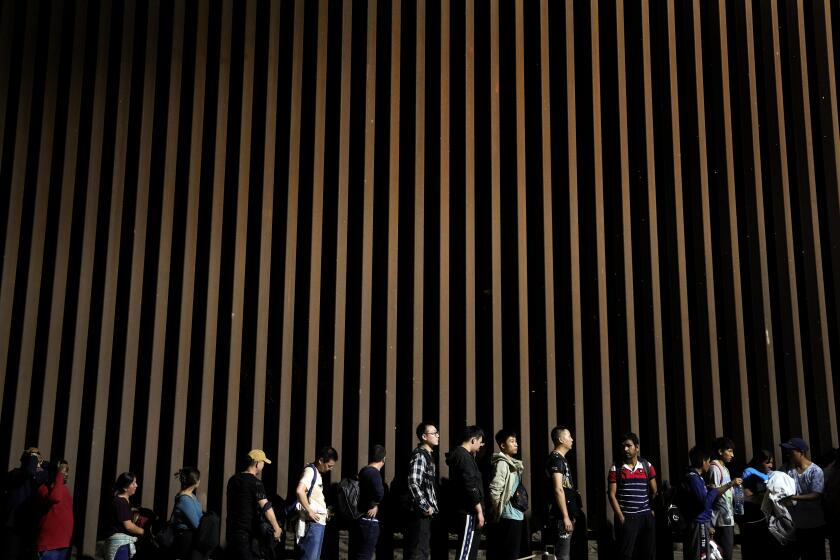Checkpoint’s Checkered Safety Draws Ire : Immigration: Recent mishaps have sparked calls to halt Border Patrol enforcement efforts at San Onofre, but authorities say the operations there are invaluable at stemming flow of illegal aliens and drugs.
A speeding sports car, attempting to evade a line of stopped traffic, swerves and rear-ends another car. The driver of the second vehicle is dead at the scene.
A truck fleeing federal agents blows through the busy early morning streets of San Clemente, ramming a car driven by a mother taking her 7-year-old son to school. The mother is hospitalized with multiple injuries.
An 80-year-old Mexican man is struck and killed by a pickup truck as he and others attempt to cross Interstate 5 in northern San Diego County. He is the 20th pedestrian hit by vehicles--and the 12th such fatality--along the stretch of the busy freeway this year.
The three episodes, which occurred within the past month, share a common root: All were related to the presence of the San Onofre Border Patrol checkpoint north of Oceanside on I-5, about 70 miles north of the border and 5 miles south of the San Diego-Orange County line.
The sports car had come upon a lane of vehicles awaiting immigration inspection. The truck tearing through San Clemente was fleeing federal agents based at the checkpoint. And the 80-year-old illegal migrant was attempting to avoid detection by hiking around the facility.
The seemingly mounting danger associated with the checkpoint has prompted some critics to call for at least a temporary shutdown of the so-called second border, or sweeping changes in the way it operates. Many contend that hazards are too great to justify the continued bloodshed.
Detractors include disgruntled motorists annoyed about the constant delays and civil libertarians and immigrant advocates, who assail the facility as a questionable incursion into individual rights. Among the most vociferous critics are residents from the neighboring communities of northern San Diego and southern Orange counties.
“I don’t see why we have to wait before it kills three or four more people before they suspend (checkpoint) operations,” said Brian J. Rice, a dentist and city councilman in San Clemente. “I don’t see why we can have a situation where we have a man on the moon in (1969) but today they can’t have a checkpoint and make it safer or easier to apprehend people.”
A federal plan to expand the facility and move it a few miles south has drawn vociferous opposition in northern San Diego County, where lawmakers fear the expanded facility will “trap” even more undocumented immigrants in a region that officials contend is already “overrun.”
“I’m totally opposed to expansion,” said Carlsbad Mayor Bud Lewis, who, like many other North County lawmakers, favors relocating the checkpoint farther south--or amassing resources at the border and doing away with the I-5 station. “They can put the bucks down at the border.”
To U.S. authorities, the I-5 checkpoint is vital. It is the busiest of 30 such stations nationwide that serve, in the words of one official, as “linebackers”--picking up the slack when the “defense” at the porous U.S.-Mexico boundary has been breached. The checkpoints are on all major arteries leaving the border areas, from Texas to California.
While vowing to bolster safety, authorities bristle at the suggestion that the I-5 facility be shut. In fact, authorities are awaiting a planned $32-million expansion that, in a few years, is expected to transform the station into a permanent, 16-lane fixture. “We’re not going to close down that checkpoint,” said Ben Davidian, INS western regional commissioner. “We’ve got a very important job to do there.”
Agents based at the checkpoint--located along the nation’s busiest immigrant-smuggling corridor--conducted a record 75,000 arrests of illegal migrants during the fiscal year that ended Sept. 30. That total exceeds the sum of all combined arrests from the other 29 Border Patrol checkpoints nationwide, including the station along I-15 near Temecula.
Caches of illicit drugs, arms, stolen vehicles, smuggled merchandise and contraband--from illegally imported foodstuffs to computer equipment--are among the annual enforcement booty. (Court records show that cocaine busts at the I-5 checkpoint increased from a single seizure in 1985 to 14 in 1989.)
“They’re integral to our operations,” Duke Austin, spokesman for INS Commissioner Gene McNary in Washington, said of the checkpoints. “It would be unwise to say that the only thing that an alien ever had to worry about was penetrating the ‘thin green line’ at the border,” added Austin, alluding to green-uniformed U.S. Border Patrol agents.
Even critics concede the checkpoint’s utility. “It’s extremely effective, unfortunately,” said Charles Wheeler, director of the National Immigration Law Center, an immigrant-advocate group in Los Angeles. Still, critics question whether the station’s deterrent value outweighs the danger it poses.
“I think the option of shutting it down is a real one,” said Roberto Martinez, border representative in San Diego for the American Friends Service Committee, a Quaker social service organization. “There’s nothing wrong with shutting it down until a solution is reached. Or at least until some precautions are made that would ensure the safety of victims in that area.”
Added Wheeler: “I think the whole thing is ludicrous and doesn’t merit the risking of people’s lives. . . . We’re not really after hardened criminals, so we shouldn’t be taking these kinds of risks.”
On the morning of Sept. 18, the Rev. Mark Huggenvik, a Lutheran pastor in San Clemente, initially didn’t know he was incurring a risk. He had stopped his car at a red light along El Camino Real when a speeding truck being pursued by two Border Patrol vehicles approached head-on, narrowly missing him.
“I was thinking that if I make one move, and if the oncoming driver reacts at all, then I’m dead,” recalled Huggenvik, who noted that the incident occurred at about 8:20 a.m., when scores of children were waiting for school buses. “If the runaway truck or one of the pursuit vehicles had gone out of control, they could have taken out 25 people. . . . I think the Border Patrol has a right to do its job, but I don’t think they have any right to put citizens in town in a life-threatening situation. We’re killing people by taking care of the symptoms.”
The chase ended when the truck, driven by a suspected illegal migrant, rammed into a car driven by Linda Delaine, who had her two sons, ages 7 and 2, inside. She suffered eye and facial injures and still experiences back and neck problems, according to her husband, David Chaffee, a San Clemente attorney.
“I’m in favor of law enforcement, but I think they need to establish some better guidelines about how to chase, and when,” said Chaffee, a former prosecutor.
The chase incident--followed six days later by the death of the female motorist whose vehicle was rear-ended by another passenger car just south of the checkpoint--reignited what has for years been a volatile debate in the beach community. “We’re talking about a situation that is absolutely intolerable,” said San Clemente Mayor Candace Haggard.
U.S. authorities say that they exercise maximum caution during chases that routinely result--about once every two days--when vehicles attempt to run the checkpoint. Injuries, they note, are relatively rare following such pursuits. (Of almost 200 checkpoint-related chases in the past year, according to the Border Patrol, only four or five resulted in injuries, none of them fatal.)
For all the antagonism that it engenders, the I-5 checkpoint is, in appearance, a modest, makeshift-looking place. It is situated amid the vast, sparsely populated landscape of Camp Pendleton, the Marine Corps base that serves as an open-space buffer between the rapidly expanding suburbs of San Diego and Orange counties. The checkpoint, which is just north of a state truck-weighing station, consists of parking areas usually filled with green-and-white Border Patrol vehicles and several drab structures, including a headquarters trailer and often-crammed temporary detention facilities.
Officials say the checkpoint only operates 70% to 90% of the time because of personnel shortages and safety concerns. For safety reasons, the station is still routinely “down”--not in operation--during inclement weather and when traffic is especially heavy, such as on weekend evenings.
The volume of traffic is massive, as are the resulting nerve-fraying backups, as would be expected along the main north-south artery between San Diego and Orange counties. Each day, according to the state Department of Transportation, an average of 115,000 vehicles--more than one per second--drive by the checkpoint. Vehicles in the area average 70 m.p.h.
On a recent Saturday evening, the goose-necked line of slow-moving vehicles south of the flood-lit checkpoint reached about 1.5 miles within 20 minutes after agents began screening motorists. A light rain about an hour later prompted authorities to shut the facility down for safety reasons.
When the checkpoint is “up,” traffic cones funnel vehicles into two or three lanes. Border Patrol agents stand at the head of the lanes, closely observing northbound traffic, waving on the vast majority of vehicles but directing potential violators to an adjacent secondary inspection area.
The 90 agents based at the facility also routinely patrol nearby terrain, which is regularly traversed on foot by people attempting to evade inspection. In addition, agents check freight and passenger trains in nearby Oceanside.
Among those arrested on a recent evening: A group of nine Mexicans--three men, three women and three children--who agents discovered huddled in the brush along the southbound lanes of I-5. “We find ‘em here all the time,” said the arresting officer, as he led the group into a Border Patrol van for transport to the checkpoint, and, ultimately, back to Tijuana.
The facility’s mission dates to the 1920s, when, U.S. immigration officials said, temporary checkpoints were established on roads leading north from the border. The checkpoints were put in a number of different locations, including, at one point, in what is now the area of Torrey Pines State Park, south of Del Mar. It was moved to its current position in March, 1971, after completion of the freeway.
Civil libertarians have traditionally objected to the checks as unconstitutional incursions into Fourth Amendment protections against unreasonable searches and seizures. However, a 1976 Supreme Court decision upheld the legality of brief stops of persons and vehicles for immigration-related questioning.
For many Latinos, both foreign- and U.S.-born, the checkpoint is a sometimes-bitter reminder that they are not always welcome. Critics say agents often appear to question Latino motorists more frequently than non-Latinos, although Border Patrol officials do not acknowledge such a pattern.
“I don’t know whether most people stopped there are Latinos,” said Ted Swofford, Border Patrol supervisory agent. “I do know that the vast majority of people arrested there for smuggling aliens are Latinos.”
The checkpoint’s effect on illegal immigration can be gauged by its impact on the smuggling industry. For many, the facility represents the final barrier in an often-hazardous voyage that has stretched for thousands of miles.
Its presence has spawned a network of coyotes who routinely stash their “loads” south of the checkpoint in safe houses, fields and the Aliso Creek highway rest area at the South end of Camp Pendleton, patiently waiting for the checkpoint to shut down before making their runs north. Spotters and other smuggling confederates, many of them legal U.S. residents, closely monitor the checkpoint, driving through the station, alert for a sudden shutdown that will prompt frantic telephone calls and ultimately spring the backed-up loads. Smugglers routinely charge double--about $300 per person--to transport undocumented clients north of the checkpoint.
But the final barrier can also be the most risky one. Evading the checkpoint can be a perilous undertaking, as the family of Custodio Aguilar learned on the evening of Sept. 22. Shortly after 8 p.m., the 80-year-old Aguilar and two other relatives attempted to cross I-5 at a spot south of the checkpoint. They, like many others, hoped to trek around the facility and later catch a ride north, eventually reuniting with family members settled in the Los Angeles area. But the old man stumbled and was hit by a truck. He was pronounced dead at the scene.
His was the 12th such death during 1990. The carnage has galvanized criticism of the checkpoint and has resulted in a number of heightened safety measures, including the posting of freeway signs and lights alerting motorists and pedestrians of the unexpected danger. (Ironically, the checkpoint was not even in operation when Aguilar and the others attempted to circumvent it on foot.)
“I was so scared,” Patricia Palomino, a niece of Aguilar who accompanied him that night, recalled afterward from a relative’s home in Palmdale, where she finally arrived after her uncle’s death. “I think they should get rid of it (the checkpoint), or put it somewhere else. . . . I had no idea it was so dangerous. If I had known how hazardous it was, believe me I would have stayed home and would never have come. But people don’t know. And they keep coming, not knowing what they face.”
More to Read
Start your day right
Sign up for Essential California for news, features and recommendations from the L.A. Times and beyond in your inbox six days a week.
You may occasionally receive promotional content from the Los Angeles Times.
